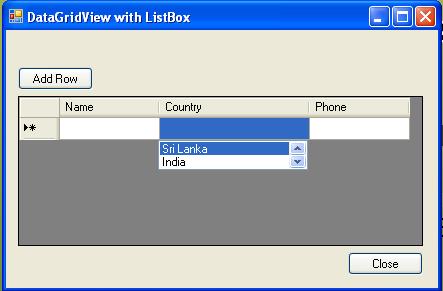
Introduction
We can add DataGridViewComboBoxColumn control to a specified column of a Standard DataGridView control that comes with .NET. There are some limitations with that control such as when entering a cell it is not popup that displays its content. Another thing is there is limited number of component support with DataGridView such as DataGridViewButtonColumn, DataGridViewCheckBoxColumn, DataGridViewComboBoxColumn, etc. It is difficult to add additional components to DaraGridView control.
In this article, I have discussed how to develop a control that inherits standard features of DataGridView and adds additional features to that control. By locking this NewDataGridView control, you will be able to develop a DataGridView control adding many more features as you wish.
Using the Code
How to add this control to your project?
Add AdvDataGridView and AdvListBox projects or its DLL to your solution.

How to Add this Control into your Form?
Drag and drop NewDataGridView control from ToolBox into your form.

How to add ListBox to DataGridView Control?
After adding NewGridView control to your form, you should add ListBox according to your requirements. Note: Before you add ListBox, columns should be added to the NewDataGridView. Listbox can be added through the property window of NewDataGridView control. Use ListBox Details section.

After adding a ListBox, you should bind it with a particular column of NewDataGridView. To do that, you have to use Binding Column section of property window of ListBox.

Now you have to define EventHandler for each ListBox that you have added to the NewDataGridView component for assigning a selected item to a cell and hide that ListBox when double clicked on the listbox. Here is the code for that:
using System;
using System.Collections.Generic;
using System.ComponentModel;
using System.Data;
using System.Drawing;
using System.Text;
using System.Windows.Forms;
namespace Test_Application
{
public partial class Form1 : Form
{
int rowIndex, columnIndex;
public Form1()
{
InitializeComponent();
this.newDataGridView1.ListBoxCollection[0].DoubleClick +=
new EventHandler(ListBox1_DoubleClick);
}
void ListBox1_DoubleClick(object sender, EventArgs e)
{
this.newDataGridView1[columnIndex, rowIndex].Value =
this.newDataGridView1.ListBoxCollection[0].SelectedItem.ToString();
this.newDataGridView1.ListBoxCollection[0].Visible = false;
}
private void newDataGridView1_CellEnter
(object sender, DataGridViewCellEventArgs e)
{
rowIndex = e.RowIndex;
columnIndex = e.ColumnIndex;
}
private void btnClose_Click(object sender, EventArgs e)
{
this.Close();
}
private void btnAddRow_Click(object sender, EventArgs e)
{
this.newDataGridView1.Rows.Add();
}
}
}
History
- 7th March, 2008: Initial post
I'm working with SAP and Microsoft Technologies such as C#, MS SQL server, ASP.NET, ASP.NET MVC, WebAPI.
 General
General  News
News  Suggestion
Suggestion  Question
Question  Bug
Bug  Answer
Answer  Joke
Joke  Praise
Praise  Rant
Rant  Admin
Admin 







 ) and it results with the above error.
) and it results with the above error.